|

|
|
| |
|
China Oil Painting Direct
|
|
100% hand painted, 100%
cotton canvas,
100% money back if not satisfaction.
|
|
|
|
ART WORKS
INDEX
A B C D E F G H I J K L M N O P Q R S T U V W X Y Z
|
|
ARTISTS
INDEX
A B C D E F G H I J K L M N O P Q R S T U V W X Y Z
|
|
|
|
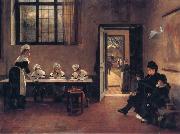 |
George Adolphus Storey 
|
|
(1834-1919), Painter
was an English portrait painter, genre painter and illustrator. Storey was born in London, but educated in Paris. When he returned to London, he worked briefly for an architect before studying under J. M. Leigh and J.L. Dulong. Though not a pupil he was also encouraged by William Behnes the sculptor, whose studio he visited. He exhibited at the Royal Academy from 1852 and studied at the Royal Academy schools from 1854. He was strongly incluenced by the Pre-Raphaelites but gave them up under influence of Charles Robert Leslie. Storey worked in North London, establishing a reputation as a genre and portrait painter, and also as an illustrator. He drew elegant pictures of middle class people for love stories and the like. Storey became ARA in 1875 and was a member of the Arts Club from 1874-95. He exhibited at the British Institution, the Royal Society of British Artists in Suffolk Street and the New Watercolour Society. He also published his autobiography in 1899, containing valuable information about the St John's Wood Clique, of which he was a member until he moved to Hampstead. From 1900, he was also the Professor of Perspective at the Royal Academy, and became RA in 1914.
|
|
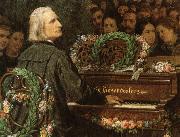 |
george bernard shaw 
|
|
Born: 26 July 1856
Birthplace: Dublin, Ireland
Died: 2 November 1950 (natural causes)
Best Known As: The author of Pygmalion
|
|
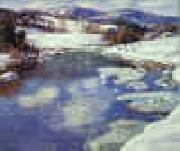 |
George Gardner Symons 
|
|
1861-1930
|
|
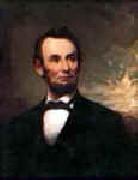 |
George H Story 
|
|
1835-1923
|
|
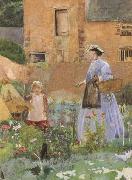 |
George John Pinwell,RWS 
|
|
1842-1875
English illustrator and painter. He was born in humble circumstances and was largely untrained. He was briefly a student at St Martin's Lane Art School and at Heatherley's. From 1863 he contributed woodblock illustrations to magazines, establishing his reputation in 1865 with the Dalziel brothers' editions of The Arabian Nights and The Works of Oliver Goldsmith. Pinwell's finest drawings were commissioned for the Dalziels' poetry gift-books. With another illustrator, John William North (1842-1924), he worked at Halsway Manor in Somerset in 1865, experimenting with formal effects based on the structure of stone farm buildings or on the wooden beams of barn interiors (his drawings do not seem to have survived). Some of the illustrations for A Round of Days (1866) and Wayside Posies (1867) present an ideal vision of the countryside, but a vein of social concern is also present. In The Journey's End, from Wayside Posies, a strolling player lies dead, worn out by hardship and hunger. For an illustrated edition of Jean Ingelow's Poems (1867),
|
|
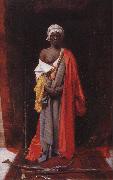 |
George L. Seymour 
|
|
British, act. 1876 - 1916
Seymour was a son of Lord Hugh Seymour (himself a son of Francis Seymour-Conway, 1st Marquess of Hertford) and Anna Horatia Waldegrave (a daughter of James Waldegrave, 2nd Earl Waldegrave) and entered the Royal Navy in 1797. He captained HMS Pallas during the Battle of Basque Roads and HMS Leonidas and HMS Fortun??e during the War of 1812. For his part in the latter war, he was appointed a CB in 1815 (alongside many other Captains) and a KCH in 1831 (and later a GCH in 1834). He rose through the ranks in the navy over the years and in 1852 was appointed a KCB (and later a GCB in 1860) and finally as an Admiral of the Fleet in 1866.
|
|
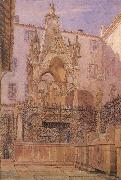 |
George Price Boyce,RWS 
|
|
1826-1897
English painter. He was the son of a prosperous wine merchant and pawnbroker. His childhood was spent in London, and in 1846 he was apprenticed to the firm of architects Wyatt & Brandon, where he remained for three years. He was always fascinated by ancient buildings but gradually lost interest in architecture as a career. In 1849, perhaps as a result of meeting David Cox at Betws-y-Coed (Gwynedd, Wales), he decided to become a painter. In the early 1850s Boyce drew landscape and architectural subjects with a fluent watercolour technique derived from Cox. In 1854 Boyce made an extended journey to Italy; he painted views of buildings in Venice and Verona
|
|
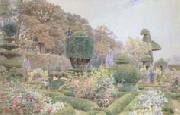 |
George Samuel Elgood,RI 
|
|
1851-1943
|
|
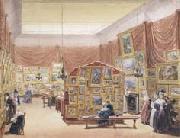 |
George Scharf 
|
|
1820-1895
British art critic, was born in London, the son of George Scharf, a Bavarian miniature painter who settled in England in 1816 and died in 1860. He studied in the schools of the Royal Academy. In 1840 he accompanied Sir Charles Fellows to Asia Minor, and in 1843 acted as draughtsman to a government expedition to the same country. After his return he devoted himself with great industry and success to the illustration of books relating to art and antiquity, of which the best known are Macaulay's Lays of Ancient Rome (1847); Milman's Horace, (1849); Kugler's Handbook of Italian Painting (1851); and Dr Smith's classical dictionaries. He also engaged largely in lecturing and teaching, and took part in the formation of the Greek, Roman and Pompeian courts at the Crystal Palace. He acted as art secretary to the great Manchester Art Treasures Exhibition of 1857, and in that year was appointed secretary and director to the newly founded National Portrait Gallery. The remainder of his life was given to the care of that institution. Scharf acquired an unrivalled knowledge of all matters relating to historic portraiture, and was the author of many learned essays on the subject. In 1885
|
|
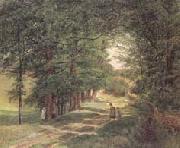 |
George Shalders 
|
|
1826-1873
|
|
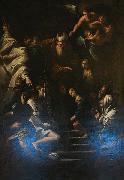 |
George Shuklin 
|
|
painted Pyotr Drozhdin in 1745
|
|
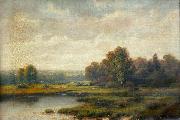 |
George Spencer 
|
|
painted Hazy Afternoon in 19th Century
|
|
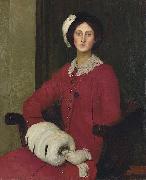 |
George Spencer Watson 
|
|
R.O.I., R.P., A.R.A., R.A. (8 March 1869, London - 11 April 1934, London) was an English portrait artist of the late romantic school who sometimes worked in the style of the Italian Renaissance. He studied at the RA Schools from 1889, exhibited at the Royal Academy from 1891. He won Royal Academy Schools Silver Medals in 1889 and 1891, and the Landseer Scholarship in 1892. He was elected R.O.I. in 1900, R.P. in 1904, A.R.A. in 1923, and a Member of the Royal Academy (R.A.) in 1932.
He married Hilda, a dancer and mime artist, and follower of the actor Edward Gordon Craig. They had a daughter, Mary Spencer Watson (1913 - 2006), who became a sculptor. In 1923 he bought Dunshay Manor in the hills of the Isle of Purbeck, after already have spent holidays in Swanage.
He died in London and a memorial exhibition was held at the Fine Art Society in the same year. There is a memorial to him in the north vestibule of St James's Church, Piccadilly, London.
Some of his works are held at Tate Britain, the Harris Art Gallery, Preston and collections in Bournemouth, Liverpool, Plymouth and the National Gallery of Canada. Born in London, Watson studied at the Royal Academy from 1889; he exhibited there from 1891 and also at the Paris salon. Retrospective exhibitions were held at the Galerie Heinemann, Munich in 1912, and at the Fine Art Society in 1914. His work A Lady in Black (1922) is owned by the Tate Collection.
|
|
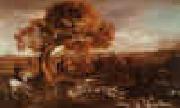 |
George Stubbs 
|
|
1724-1806
George Stubbs Galleries
George Stubbs (born in Liverpool on August 25, 1724 ?C died in London July 10, 1806) was a British painter, best known for his paintings of horses.
Stubbs was the son of a currier. Information on his life up to age thirty-five is sparse, relying almost entirely on notes made by fellow artist Ozias Humphry towards the end of Stubbs's life. Stubbs was briefly apprenticed to a Lancashire painter and engraver named Hamlet Winstanley, but soon left as he objected to the work of copying to which he was set. Thereafter as an artist he was self-taught. In the 1740s he worked as a portrait painter in the North of England and from about 1745 to 1751 he studied human anatomy at York County Hospital. He had had a passion for anatomy from his childhood, and one of his earliest surviving works is a set of illustrations for a textbook on midwifery which was published in 1751.
In 1755 Stubbs visited Italy. Forty years later he told Ozias Humphry that his motive for going to Italy was, "to convince himself that nature was and is always superior to art whether Greek or Roman, and having renewed this conviction he immediately resolved upon returning home". Later in the 1754 he rented a farmhouse in the village of Horkstow,Lincolnshire, and spent 18 months dissecting horses. He moved to London in about 1759 and in 1766 published The anatomy of the Horse. The original drawings are now in the collection of the Royal Academy.
Even before his book was published, Stubbs's drawings were seen by leading aristocratic patrons, who recognised that his work was more accurate than that of earlier horse painters such as James Seymour and John Wootton. In 1759 the 3rd Duke of Richmond commissioned three large pictures from him, and his career was soon secure. By 1763 he had produced works for several more dukes and other lords and was able to buy a house in Marylebone, a fashionable part of London, where he lived for the rest of his life.
Whistlejacket. National Gallery, London.His most famous work is probably Whistlejacket, a painting of a prancing horse commissioned by the 2nd Marquess of Rockingham, which is now in the National Gallery in London. This and two other paintings carried out for Rockingham break with convention in having plain backgrounds. Throughout the 1760s he produced a wide range of individual and group portraits of horses, sometimes accompanied by hounds. He often painted horses with their grooms, whom he always painted as individuals. Meanwhile he also continued to accept commissions for portraits of people, including some group portraits. From 1761 to 1776 he exhibited at the Society of Artists, but in 1775 he switched his allegiance to the recently founded but already more prestigious Royal Academy.
Stubbs also painted more exotic animals including lions, tigers, giraffes, monkeys, and rhinoceroses, which he was able to observe in private menageries. He became preoccupied with the theme of a wild horse threatened by a lion and produced several variations on this theme. These and other works became well known at the time through engravings of Stubbs's work, which appeared in increasing numbers in the 1770s and 1780s.
Mares and Foals in a Landscape. 1763-68.Stubbs also painted historical pictures, but these are much less well regarded. From the late 1760s he produced some work on enamel. In the 1770s Josiah Wedgwood developed a new and larger type of enamel panel at Stubbs's request. Also in the 1770s he painted single portraits of dogs for the first time, while also receiving an increasing number of commissions to paint hunts with their packs of hounds. He remained active into his old age. In the 1780s he produced a pastoral series called Haymakers and Reapers, and in the early 1790s he enjoyed the patronage of the Prince of Wales, whom he painted on horseback in 1791. His last project, begun in 1795, was A comparative anatomical exposition of the structure of the human body with that of a tiger and a common fowl, engravings from which appeared between 1804 and 1806.
Stubbs's son George Townly Stubbs was an engraver and printmaker.
|
|
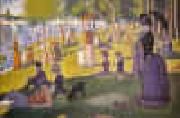 |
Georges Seurat 
|
|
French Pointillist Painter, 1859-1891
Georges-Pierre Seurat (2 December 1859 ?C 29 March 1891) was a French painter and draftsman. His large work Sunday Afternoon on the Island of La Grande Jatte, his most famous painting, altered the direction of modern art by initiating Neo-impressionism, and is one of the icons of 19th century painting
Seurat took to heart the color theorists' notion of a scientific approach to painting. Seurat believed that a painter could use color to create harmony and emotion in art in the same way that a musician uses counterpoint and variation to create harmony in music. Seurat theorized that the scientific application of color was like any other natural law, and he was driven to prove this conjecture. He thought that the knowledge of perception and optical laws could be used to create a new language of art based on its own set of heuristics and he set out to show this language using lines, color intensity and color schema. Seurat called this language Chromoluminarism.
His letter to Maurice Beaubourg in 1890 captures his feelings about the scientific approach to emotion and harmony. He says "Art is Harmony. Harmony is the analogy of the contrary and of similar elements of tone, of color and of line, considered according to their dominance and under the influence of light, in gay, calm or sad combinations".
Seurat's theories can be summarized as follows: The emotion of gaiety can be achieved by the domination of luminous hues, by the predominance of warm colors, and by the use of lines directed upward. Calm is achieved through an equivalence/balance of the use of the light and the dark, by the balance of warm and cold colors, and by lines that are horizontal. Sadness is achieved by using dark and cold colors and by lines pointing downwards.
|
|
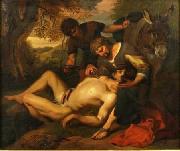 |
Gerard Seghers 
|
|
(Antwerp, 1591-18 March 1651), also Zegers, was a Flemish Baroque painter and one of the leading Caravaggisti in the Southern Netherlands.
He was the son of an innkeeper but not related to the jesuit and painter Daniel Seghers. He was possibly a student of either Abraham Janssens or Hendrick van Balen, and he showed great talent, because in 1608 aged only 17 he is listed as a master in the Guild of St. Luke. It was during his trip to Italy around 1613 that he came under the influence of Caravaggio's followers. Bartolomeo Manfredi, in particular, was influential. Many other Dutch and Flemish painters were working in the style there, such as Gerard Honthorst, which is strongly characterized half-length figures illuminated by strong lighting and dramatic chiaroscuro. One work from this period is his Judith with the Head of Holofernes in the Galleria Nazionale d'Arte Antica, Rome. Caravaggism, both in history and monumental genre paintings, continued to mark Seghers's works when he returned to Antwerp around 1620.
The Patient Job, National Gallery, Prague.He married on his return to Antwerp (ca.1621) with Catharina Wouters (d.1656), with whom he had eleven children. His son Jan-Baptist Seghers (1624-1670) also became a painter. After 1630, his palette lightens up considerably and the influence of Peter Paul Rubens is noticeable in paintings like the Adoration of the Magi (1630) in the Church of Our Lady, Bruges.
|
|
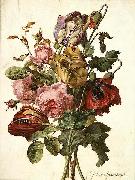 |
Gerard van Spaendonck 
|
|
(22 March 1746 - 11 May 1822) was a Dutch painter.
Gerard was born in Tilburg, an older brother of Cornelis van Spaendonck (1756-1840), who was also a renowned artist. In the 1760s he studied with decorative painter Willem Jacob Herreyns (also known as Guillaume-Jacques Herreyns) (1743-1827) in Antwerp. In 1769 he moved to Paris, and in 1774 was appointed miniature painter in the court of Louis XVI. In 1780 he succeeded Madeleine Françoise Basseporte (1701-1780) as professor of floral painting at the Jardin des Plantes, and shortly afterwards was elected a member of the Academie des beaux-arts.
Gerard van Spaendonck painted with both oil and watercolors. He contributed over fifty works to the Velins du Roi, which was a famous collection of botanical watercolors possessed by French royalty. From 1799 to 1801 he published twenty-four plates of his Fleurs Dessinees d'apres Nature (Flowers Drawn from Life), which were high-quality engravings for students of floral painting. Today, Fleurs Dessinees d'apres Nature is a highly treasured book on floral art.
In 1788 Spaendonck was appointed adviser to the Academie, and in 1795 he became a founding member of the Institut de France. In 1804 he received the Legion d'honneur and soon afterwards was ennobled by Napoleon Bonaparte. He died in Paris.
|
|
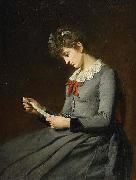 |
Geskel Saloman 
|
|
painted The Love Letter in 1889
|
|
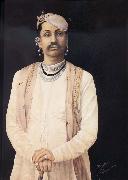 |
Ghasiram Hardev Sharma 
|
|
1868-1930
|
|
 |
Gherardo Starnina 
|
|
Italian Gothic Era Painter, ca.1360-1413
was a Florentine painter of the early Quattrocento. According to the biographer Giorgio Vasari, Starnina initially trained with Antonio Veneziano, then with Agnolo Gaddi. He is claimed to have participated in the painting of the frescos in the Castellani Chapel in Santa Croce, Florence. He is also said to have moved to Spain in 1380 to work under Juan I of Castile, and is attributed some painting in the San Blas chapel of the Cathedral of Toledo. Several paintings formerly attributed to the Master of the Bambino Vispo are now attributed to Gherardo Starnina,
|
|
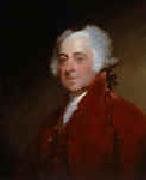 |
Gilbert Charles Stuart 
|
|
1755-1828
Gilbert Charles Stuart Locations
Gilbert Charles Stuart (born Stewart) (December 3, 1755 ?C July 9, 1828) was an American painter from Rhode Island.
Gilbert Stuart is widely considered to be one of America's foremost portraitists. His best known work, the unfinished portrait of George Washington that is sometimes referred to as The Athenaeum, was begun in 1796 and left incomplete at the time of Stuart's death in 1828. The image of George Washington featured in the painting has appeared on the United States one-dollar bill for over one century.
Throughout his career, Gilbert Stuart produced portraits of over 1,000 people, including the first six Presidents of the United States. His work can be found today at art museums across the United States and the United Kingdom, most notably the Metropolitan Museum of Art in New York City, the National Gallery of Art in Washington, D.C., the National Portrait Gallery in London, and the Museum of Fine Arts in Boston.
|
|
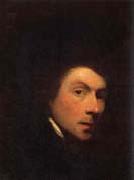 |
Gilbert Stuart 
|
|
1755-1828
Gilbert Stuart was born in North Kingston, R.I., on Dec. 3, 1755. At the age of 13 or 14 he studied art with the Scottish painter Cosmo Alexander in Newport. With Alexander he made a tour of the South and a journey to Edinburgh, where Alexander died in 1772. For about a year Stuart remained, poverty-stricken, in Scotland, but finally, working as a sailor, he managed to get back to America. There he executed a few portraits in a hard limner fashion. With the Revolutionary War threatening, his family, who had Tory sympathies, fled to Nova Scotia, and Stuart sailed for London, where he remained from 1775 to 1787. For the first 4 or 5 years, Stuart served as the first assistant of American expatriate painter Benjamin West, who had rescued him from poverty. From the first, Stuart showed an interest only in portraiture and had no desire to go into the branch of history painting West practiced. After his apprenticeship, Stuart became London's leading portrait painter, next to Joshua Reynolds and Thomas Gainsborough, whose style he emulated, as in a rare full-length portrait of William Grant of Congalton as The Skater (ca. 1782). For a while Stuart lived in splendor, but being a bad businessman and a profligate spender, he was in constant debt. He lived in Ireland from 1787 to 1792 and then returned to America to make a fortune,
|
|
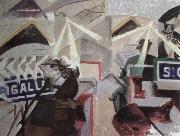 |
gino severini 
|
|
gino severini (1883 to 1966),Italian painter, mosaicist, stage designer and writer. One of the principal exponents of Futurism, he was an important link between French and Italian art. Although his most historically significant works were produced before World War I, he had a long career during which he continued to evolve his style, particularly in abstract schemes.
|
|
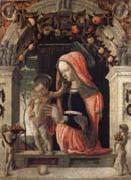 |
Giorgio Schiavone 
|
|
born circa 1433-1504
|
|
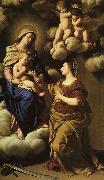 |
Giovan Battista Salvi Sassoferrato 
|
|
1605-1685
Italian
Giovan Battista Salvi Sassoferrato Gallery
|
|
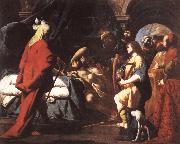 |
Giovanni Battista Spinelli 
|
|
( fl from c. 1630; dc. 1660). Italian painter and draughtsman
|
|
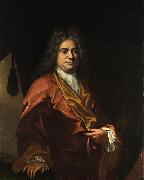 |
Giovanni Camillo Sagrestani 
|
|
(1660-1731) was an Italian painter of the Baroque era.
A native of Florence, he was a follower of the style of Carlo Cignani. His major pupil was Matteo Bonechi (1672-1726) and Giovanni Battista Ranieri del Pace. Four canvases attributed to Sagrestani can be found in the church of Santa Maria della Fraternite in Foiano della Chiana. He also executed works in the church of San Frediano in Cestello, in the Oltrarno district of Florence. Paintings in the church of SS. Annunziata in San Giovanni Valdarno are attributed to Sagrestani. An Assumption of the Virgin is found in Nancy.
|
|
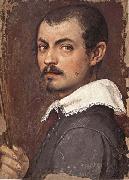 |
Giovanni da san giovanni 
|
|
1592-1636
Italian painter and draughtman. He was the most distinguished of the artists working in fresco in 17th-century Florence. An eccentric personality, he was attracted by the charm and informality of northern art and by a satirical approach to Classical themes. He went to Florence in 1608 to study in the workshop of Matteo Rosselli, where he learnt both fresco and oil painting techniques and drew extensively (Baldinucci). In 1615 he painted two ceiling canvases of Putti Supporting the Impresa of Michelangelo for a room in the Casa Buonarroti and in the same period frescoed the dome of the church of the Ognissanti, Florence (completed 1615), with a choir of musician angels. He also painted five lunettes showing scenes from the Life of St Francis in the cloister (completed 1619; in situ). In 1616 his frescoed decoration of an Allegory of Florence (destr.; preparatory drawing, Florence, Uffizi, G.D.S. U. 1122F) on the fa?ade of Cosimo II de' Medici's house in Piazza della Calza won him unexpected and lasting fame. His early works also included several tabernacles, made for patrons in the town and in the surrounding countryside. The Virgin and Child with Saints
|
|
 |
Giovanni di Pietro called lo Spagna 
|
|
ca 1450-Spoleto 1528
|
|
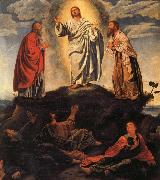 |
Giovanni Gerolamo Savoldo 
|
|
Italian Mannerist Painter , c. 1480 - aft.1548
was an Italian High Renaissance painter. Savoldo was born in Brescia, but little is known about his early years. Some sources claim he was known as Girolamo Bresciano. By 1506 he was in Parma, and by 1508, he had joined the Florentine painter??s guild. In this period he finished the Rest at the Flight from Egypt (Augsburg), the Elijah Harassed by a Crow (National Gallery of Art, Washington), and a Deposition. In 1515 he painted the Portrait of a Clad Warrior, wrongly identified with Gaston de Foix. Also from the same period his the Temptings of St. Anthony, which appears to show the influence of the Flemish Hieronymus Bosch. The works was appreciated by the commissioners from Venice, where Savoldo relocated before 1520. On June 15, 1524 he signed a contract for an altarpiece for the church of San Domenico in Pesaro (now in the Brera, Milan). In 1527, he completed a St. Hieronymus for the Brescian family Averoldi, probably the one at National Gallery of London. From the 1530s dates a Nativity at the National Gallery in Washington DC, which seems influenced by the lambent contemporary, Correggio painting on the same topic. In 1533 Savoldo painted a Madonna with Four Saints in the church of Santa Maria in Organo, while in 1537-1538 he executed the altarpiece for the main altar of Santa Croce, Brescia.
|
|
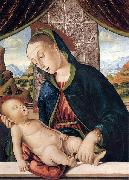 |
Giovanni Santi 
|
|
(c. 1435 - 1 August 1494) was an Italian painter and decorator, father of Raphael. He was born at Colbordolo in the Duchy of Urbino. He was a petty merchant for a time; he then studied under Piero della Francesca. He was influenced by Fiorenzo di Lorenzo, and seems to have been an assistant and friend of Melozzo da Forle. He was court painter to the Duke of Urbino and painted several altarpieces, two now in the Berlin Museum, a Madonna in the church of San Francesco in Urbino, one at Santa Croce on Fano, one in the National Gallery at London, and another in the gallery at Urbino; an Annunciation at the Brera in Milan; a resurrected Christ in the Museum of Fine Arts, Budapest; and a Jerome in the Lateran. He died in Urbino.
|
|
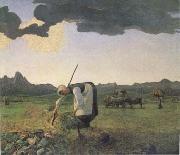 |
Giovanni Segantini 
|
|
Italian Art Nouveau Painter, 1858-1899
Italian painter and draughtsman. An exponent of DIVISIONISM, he was the only Italian painter of the late 19th century to have enjoyed an unbroken international reputation, especially in Germany and Austria.
|
|
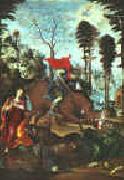 |
Giovanni Sodoma 
|
|
1477-1549
Giovanni Sodoma Galleries
|
|
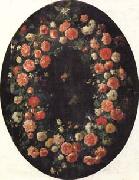 |
Giovanni Stanchi 
|
|
Italian, 1608-died after 1673
|
|
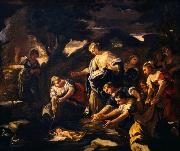 |
Giuseppe Simonelli 
|
|
(Naples, c.1650 - 1710) was an Italian painter.
Born in Naples around 1650, Simonelli was one of the most important painters of the school of Luca Giordano. His early works were often retouched by Giordano to such a degree that some of them were confused with those of the master. He learned Giordanoes art so well that when the master left Naples for the Spanish court in 1692, he was assigned the task of completing the unfinished Neapolitan works for delivery to clients. Reliable details of his own production are available as from 1686, when he received the final payment for a painting of Holy Martyrs for the Jesuit college in Trapani. His most celebrated works are the series of 28 paintings for the Church of the Annunziata in Aversa, produced between 1702 and 1703 together with his brother Gennaro. He worked continuously right up to his death in 1710.
|
|
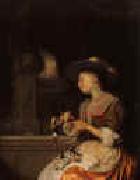 |
Godfried Schalcken 
|
|
Dutch
1643-1706
Godfried Schalcken was born in 1643 at Dordrecht, and he studied under Samuel van Hoogstraten in Dordrecht before he moved to Leiden, into the studio of Gerard Dou (1613-1675), one of Rembrandt's most famous pupils. His earlier genre pictures very closely resemble Dou's work. He worked in Leiden until c. 1675, then returning to Dordrecht until 1691, after which he settled in The Hague, where he continued to paint until his death, near age 63, in 1706. He also visited England (1692-1697), but his uncouth manners and bad temper alienated him from the society there. In 1703 he was employed by Johann Wilhelm, Elector Palatine in D??sseldorf.
Mary Stanhope, Viscountess Fane, detail, 1702.Schalcken painted several portraits, of which the half-length of William III of England, now in the Rijksmuseum, Amsterdam, is a good example. Like Dou, Schalcken specialised in small scenes it by candlelight, a technique that found favour with the fijnschilders. Examples are in Buckingham Palace, the Louvre, Vienna and Dresden. His painting, Lady, Come into the Garden (Buckingham Palace), was singled out by his pupil Arnold Houbraken as representative of his oeuvre. Other good examples are Old Woman Scouring a Pan and Soldier Giving Money to a Woman (London, National Gallery), Ceres Seeking Proserpine and Old Man Writing (Louvre), Girl Blowing Out Taper (Munich), Girl Reading Letter (Dresden Gallery), The Boy Angling (Berlin); and Toilet by Candle (The Hague). The Buckingham Palace collection also possesses an interior by Schalcken. His history paintings are less-well known.
|
|
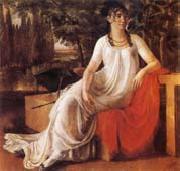 |
Gottlieb Schick 
|
|
romanticism artist. German, 1776-1812
German painter. He trained at the H?he Karlsschule in Stuttgart (1795-7) under the classically-orientated painter Philipp Friedrich von Hetsch (1758-1839), a pupil of David. Schick also took private lessons (1797-8) with the sculptor Johann Heinrich von Dannecker. From 1799 to 1802 Schick studied in Paris under David, and he soon became one of David's favourite students. He made two unsuccessful attempts to win the Prix de Rome with compositions that derived from the style of David. However, greater independence is seen in his life-size painting Eve (1800; Cologne, Wallraf-Richartz-Mus.), a magnificent allegory of Beauty synthesizing a classically-orientated reinterpretation of ancient art and a proto-Romantic interpretation of biblical subject-matter, inspired by Milton's Paradise Lost. As Schick himself stated (letter to Dannecker, 10 July 1800), he had tried to emulate both the Medici Venus and the female figures of Raphael. In 1802, on a pension from Frederick II, Duke of Werttemburg, Schick moved to Rome and for almost a decade played a leading role in Roman artistic life. His friendship with Joseph Anton Koch led to mutual influence in the work of the two artists. Koch was indebted to Schick for invaluable hints on oil painting and for choice of subjects. For a fortnight in July 1805, Schick exhibited in the Pantheon his large oil painting The Sacrifice of Noah (2.50*3.27 m, 1804; Stuttgart, Staatsgal.). The work was inspired by Raphael's Old Testament frescoes in the Vatican Loggie; and it brought Schick enormous success. Despite financial hardship, Schick continued to work indefatigably, and without waiting for commissions, on a wide variety of projects. These included biblical and mythological subjects as well as portraits. Between 1806 and 1808 he completed his Apollo among the Shepherds (Stuttgart, Staatsgal.), a subject he had attempted while still in Paris and then again in Rome in 1805. The second Rome version had clearly gained through Schick's concentrated thought over a period of several years, and the result represented an avowal of faith both in the artist's own gifts and in German Classicism.
|
|
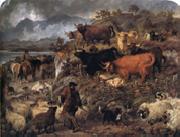 |
Gourlay Steell 
|
|
Scottish , 1819-1894
|
|
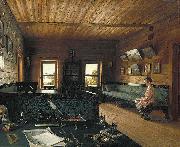 |
Grigoriy Soroka 
|
|
(Russian, real surname Vasilyev. November 27 [O.S. November 15] 1823-April 22 [O.S. April 10] 1864) was a Russian painter, one of the most notable members of Venetsianov school.
Soroka was born in Pokrovskoye village (Tver Guberniya), in the family of landowner Milyukov. In 1842-1847 he studied art from Alexey Venetsianov then he was returned to his owner. In 1850s-1860s he resided in his home village. He fell in love with his owners's daughter Lydia but was forcibly married to a serf woman. After the emancipation reform of 1861 in Russia, Soroka remained under the serfdom system. He made a formal complaint but it was rejected and he was flogged. Soroka's body was found in the baking room where he had hanged himself. His beloved Lydia poisoned herself soon after.
|
|
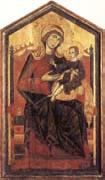 |
Guido da Siena 
|
|
Italian Byzantine Style Painter, 13th Century
He may have made significant advances in the techniques of painting, much as Cimabue much later accomplished. However, there is some debate about this. Guido is primarily known for a painting which is now split into several pieces. The church of S. Domenico in Siena contains a large painting of the Virgin and Child Enthroned with six angels above. The Benedictine convent of the same city has a triangular pinnacle representing the Saviour in benediction, with two angels. This was once a portion of the same composition, which was originally a triptych. The principal section of this picture has a rhymed Latin inscription, giving the painter's name as Guido de Senis, with the date 1221. However, this may not be genuine, and the date may really read as 1281. There is nothing particular to distinguish this painting from other work of the same period except that the heads of the Virgin and Child are much superior ?C in natural character and graceful dignity ?C to anything painted before Cimabue. As a result, there is some dispute as to whether these heads are really the work of a man who painted in 1221, long before Cimabue. Crowe and Cavalcaselle have proposed that the heads were repainted in the 14th century, perhaps by Ugolino da Siena. If Crowe and Cavalcaselle are right, Cimabue maintains his claim to the advancement of the art. Beyond this, little is known of Guido da Siena. A picture in the Academy of Siena is attributed to him (a half-figure of the Virgin and Child, with two angels), which dates (probably) between 1250 and 1300.
|
|
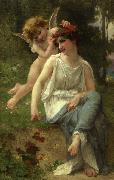 |
Guillaume Seignac 
|
|
He was born in Rennes, France, in 1870, and died in 1924. He started training at the Academie Julian in Paris, where he spent 1889 through 1895. He had a lot of teachers there, including Gabriel Ferrier, and Tony Robert-Fluery. Tony Robert Fluery was a noted history and genre artist. Gabriel Farrel, on the other hand, had been an awarded Prix de Rome. He had another one named William Bouguereau.
|
|
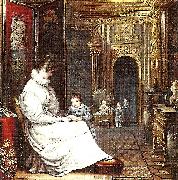 |
gustaf soderberg 
|
|
1897 -- 1910
|
|
 |
Gustavo Simoni 
|
|
Italian, 1846-1926
|
|
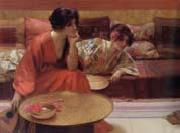 |
H.Siddons Mowbray 
|
|
American Painter, 1858-1928
|
|
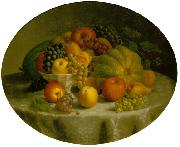 |
Hannah Brown Skeele 
|
|
Hannah Brown Skeele (1829 - 1901)
|
|
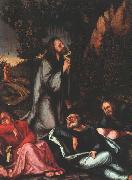 |
Hans Leonhard Schaeufelein 
|
|
1480-1540
German
Hans Leonhard Schaeufelein Gallery
Hans Leonhard Schäufelein (c. 1480 ?C 1540) was a German painter, designer, and wood engraver.
He was born in Nuremberg, probably studied under Wohlgemut, and then became the assistant of Durer, whom he imitated. In 1512 he went to Augsburg and in 1515 removed to Nordlingen.
He is a graceful narrator, and his types, though rarely accurately drawn, are attractive, but he lacks power and depth. Characteristic early paintings are the altarpiece at Ober Sankt Veit, near Vienna (1502), "Scenes from the Life of Christ" (Dresden Gallery), and "St. Jerome" (Germanic Museum, Nuremberg).
To his Nordlingen period belong his masterpiece, the so-called "Ziegler Altar" for St. George's Church (1521), part of which is still in the church, part in the museum; "Scenes from the Story of Judith," in the town hall; and the illuminated Psalter for Count von Ottingen, now in the Berlin print room. His most important woodcuts are those for the Theuerdank of Emperor Maximilian.
Schäufelein created a playing card deck about 1535, which is regarded as a highlight in German 16th century playing card production.
|
|
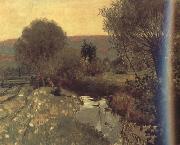 |
Hans Sandreuter 
|
|
1850 -1901
|
|
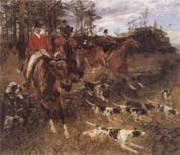 |
Hans Schmidt 
|
|
19th
|
|
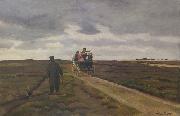 |
Hans Smidth 
|
|
Hans Ludvig Smidth (2 October 1839, Nakskov - 5 May 1917, Frederiksberg) was a Danish painter. He is remembered above all for his paintings of Jutland and its local inhabitants.
Smidth was the son of the city bailiff of Skive, Edvard Philip Smidth, and the brother of Verner Frederik Læssøe Smidth who founded the cement concern F. L. Smidth & Co. After graduating from school, he began to study medicine but gave it up in favour of art. In 1861, he entered the Danish Academy where he studied under Niels Simonsen. In 1866, he began to experience financial difficulties and left the Academy to continue his studies himself, painting scenes of Limfjord and the moors of Jutland. He first exhibited at Charlottenborg in 1867 with two landscape paintings and continued to exhibit there over the years. His works depicted country life in Jutland, most of them with an emphasis on animals and local figures. He had a talent for form and detail but his use of colour was rather dry, dimishing the appeal of his paintings to the general public. In 1870-71, he studied under Vilhelm Kyhn. As the years went by, Smidth's style developed considerably, earning him the Neuhausen Prize in 1877 for En fremmed spørger om Vej i Bondegaarden paa Heden which was not only technically impressive but showed a fineness of tone. His increasing acceptance as a master of painting in Jutland paved the way for his reputation at the national level.
In fact Smidth had to wait until the year 1900 before he experienced full recognition. That year the Danish Art Society arranged a special exhibition of the artist's work although he was now 60. Unexpectedly 290 of the 300 works sketches and drawings exhibited were sold. In retrospect, his paintings are free of historical or mythical figures, they do not interpret scenes along the lines of the Skagen Painters. They simply depict the views of the people and the countryside as he saw them. His paintings show he had the same respect for the land as the peasants themselves.
|
|
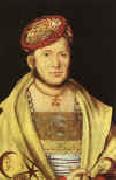 |
Hans Suss von Kulmbach 
|
|
1476-1522
German
Hans Suss von Kulmbach Gallery
German painter and graphic artist. His real name was Hans S??ss. In general his work reveals the influence of D??rer, but he had little of the master's power. Von Kulmbach worked chiefly in Nuremberg, although he probably spent several years in Cracow as court painter. His masterpiece is the Tucher altarpiece for the Church of St. Sebald in Nuremberg. He also executed portraits and designs for painted glass.
|
|
|
|
|
|
|
|
|
| Wholesale China Oil Painting Wholesale Oil Painting China Xiamen Portrait Reproduction on canvas Chinese Oil Painting Wholesale USA Oil Painting |
|
|
|
|